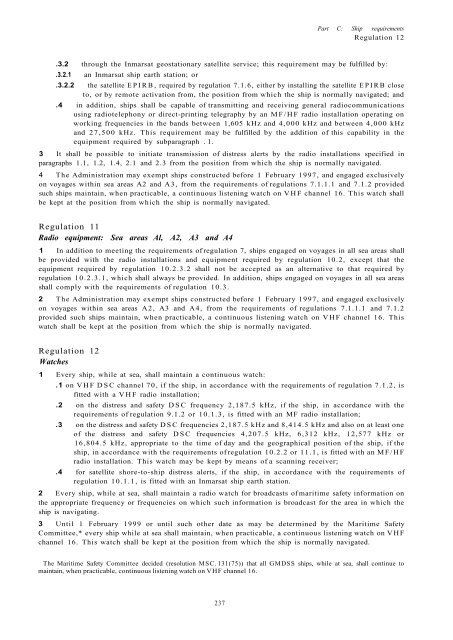Solas Consolidated Edition 2009.pdf
Solas Consolidated Edition 2009 for maritime
Solas Consolidated Edition 2009 for maritime
Create successful ePaper yourself
Turn your PDF publications into a flip-book with our unique Google optimized e-Paper software.
Part C: Ship requirements<br />
Regulation 12<br />
.3.2 through the Inmarsat geostationary satellite service; this requirement may be fulfilled by:<br />
.3.2.1 an Inmarsat ship earth station; or<br />
.3.2.2 the satellite EPIRB, required by regulation 7.1.6, either by installing the satellite EPIRB close<br />
to, or by remote activation from, the position from which the ship is normally navigated; and<br />
.4 in addition, ships shall be capable of transmitting and receiving general radiocommunications<br />
using radiotelephony or direct-printing telegraphy by an MF/HF radio installation operating on<br />
working frequencies in the bands between 1,605 kHz and 4,000 kHz and between 4,000 kHz<br />
and 27,500 kHz. This requirement may be fulfilled by the addition of this capability in the<br />
equipment required by subparagraph . 1.<br />
3 It shall be possible to initiate transmission of distress alerts by the radio installations specified in<br />
paragraphs 1.1, 1.2, 1.4, 2.1 and 2.3 from the position from which the ship is normally navigated.<br />
4 The Administration may exempt ships constructed before 1 February 1997, and engaged exclusively<br />
on voyages within sea areas A2 and A3, from the requirements of regulations 7.1.1.1 and 7.1.2 provided<br />
such ships maintain, when practicable, a continuous listening watch on VHF channel 16. This watch shall<br />
be kept at the position from which the ship is normally navigated.<br />
Regulation 11<br />
Radio equipment: Sea areas Al, A2, A3 and A4<br />
1 In addition to meeting the requirements of regulation 7, ships engaged on voyages in all sea areas shall<br />
be provided with the radio installations and equipment required by regulation 10.2, except that the<br />
equipment required by regulation 10.2.3.2 shall not be accepted as an alternative to that required by<br />
regulation 10.2.3.1, which shall always be provided. In addition, ships engaged on voyages in all sea areas<br />
shall comply with the requirements of regulation 10.3.<br />
2 The Administration may exempt ships constructed before 1 February 1997, and engaged exclusively<br />
on voyages within sea areas A2, A3 and A4, from the requirements of regulations 7.1.1.1 and 7.1.2<br />
provided such ships maintain, when practicable, a continuous listening watch on VHF channel 16. This<br />
watch shall be kept at the position from which the ship is normally navigated.<br />
Regulation 12<br />
Watches<br />
1 Every ship, while at sea, shall maintain a continuous watch:<br />
.1 on VHF DSC channel 70, if the ship, in accordance with the requirements of regulation 7.1.2, is<br />
fitted with a VHF radio installation;<br />
.2 on the distress and safety DSC frequency 2,187.5 kHz, if the ship, in accordance with the<br />
requirements of regulation 9.1.2 or 10.1.3, is fitted with an MF radio installation;<br />
.3 on the distress and safety DSC frequencies 2,187.5 kHz and 8,414.5 kHz and also on at least one<br />
of the distress and safety DSC frequencies 4,207.5 kHz, 6,312 kHz, 12,577 kHz or<br />
16,804.5 kHz, appropriate to the time of day and the geographical position of the ship, if the<br />
ship, in accordance with the requirements of regulation 10.2.2 or 11.1, is fitted with an MF/HF<br />
radio installation. This watch may be kept by means of a scanning receiver;<br />
.4 for satellite shore-to-ship distress alerts, if the ship, in accordance with the requirements of<br />
regulation 10.1.1, is fitted with an Inmarsat ship earth station.<br />
2 Every ship, while at sea, shall maintain a radio watch for broadcasts of maritime safety information on<br />
the appropriate frequency or frequencies on which such information is broadcast for the area in which the<br />
ship is navigating.<br />
3 Until 1 February 1999 or until such other date as may be determined by the Maritime Safety<br />
Committee,* every ship while at sea shall maintain, when practicable, a continuous listening watch on VHF<br />
channel 16. This watch shall be kept at the position from which the ship is normally navigated.<br />
The Maritime Safety Committee decided (resolution MSC. 131(75)) that all GMDSS ships, while at sea, shall continue to<br />
maintain, when practicable, continuous listening watch on VHF channel 16.<br />
237


